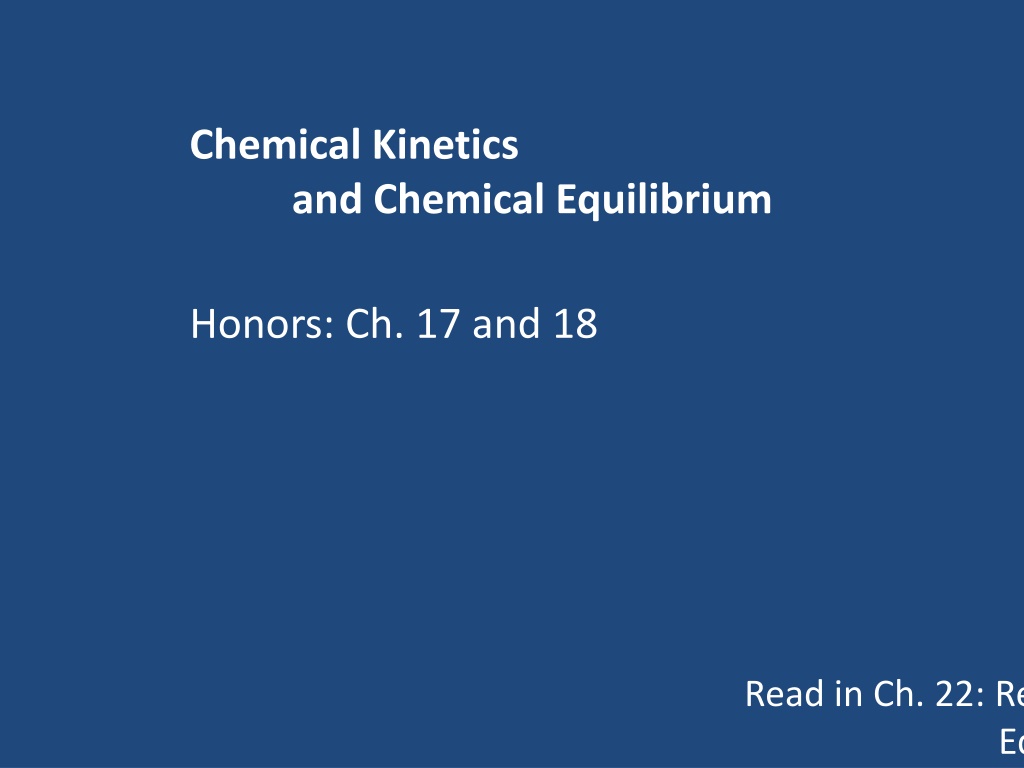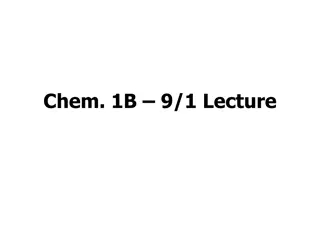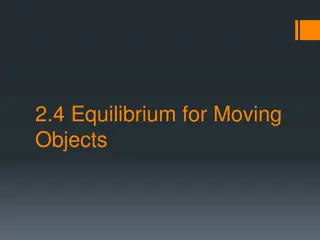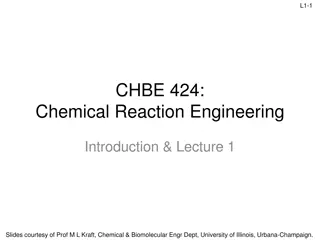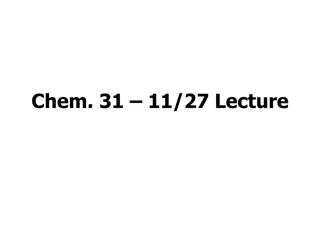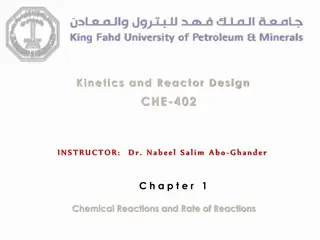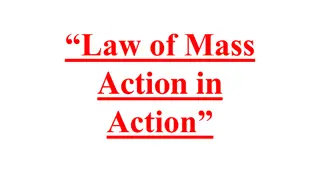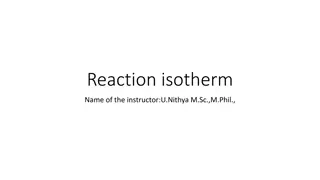Understanding Chemical Kinetics and Equilibrium in Reactions
Explore the basic concepts of reaction rates, collision theory, activation energy, and energy diagrams in chemical kinetics and equilibrium. Learn how particles must collide with the correct orientation and enough energy to form an unstable activated complex. Discover the role of activation energy in overcoming barriers in both exothermic and endothermic reactions.
Download Presentation

Please find below an Image/Link to download the presentation.
The content on the website is provided AS IS for your information and personal use only. It may not be sold, licensed, or shared on other websites without obtaining consent from the author. Download presentation by click this link. If you encounter any issues during the download, it is possible that the publisher has removed the file from their server.
E N D
Presentation Transcript
Chemical Kinetics and Chemical Equilibrium Honors: Ch. 17 and 18 Read in Ch. 22: Reaction Rates pp 543 Equilibrium pp 560
Chemical Kinetics Reaction Rates
Reaction Rates: Basic Concepts Collision Theory According to the collision theory, atoms, ions, and molecules must collide with each other in order to react. The following three statements summarize the collision theory. 1. Particles must collide in order to react. 2. The particles must collide with the correct orientation.
Reaction Rates: Basic Concepts 3. The particles must collide with enough energy to form an unstable activated complex, also called a transition state, which is an intermediate particle made up of the joined reactants.
The minimum amount of energy that colliding particles must have in order to form an activated complex is called the activation energy of the reaction. Particles that collide with less than the activation energycannot form an activated complex.
Activation Energy and Energy Diagrams CH4 + 2O2 CO2 + 2H2 O + Energy N2 + 2O2 + Energy 2NO2
Activation Energy and Energy Diagrams CO + NO2 CO2 + NO In an exothermic reaction, molecules collide with enough energy to overcome the activation energy barrier, form an activated complex, then release energy and form products at a lower energy level.
Activation Energy and Energy Diagrams In the reverse endothermic reaction, the reactant molecules lying at a low energy level must continually absorb energy to collide with enough force to overcome the activation energy barrier and form high-energy products. CO2 + NO CO + NO2
Factors Affecting Reaction Rates 1. The Nature of Reactants An important factor that affects the rate of a chemical reaction is the reactive nature of the reactants. Some substances react more readily than others. The more reactive a substance is, the faster the reaction rate.
2. Concentration Reactions speed up when the concentrations of reacting particles are increased. Think about a reaction where reactant A combines with reactant B. At a given concentration of A and B, the molecules of A collide with B to produce AB at a particular rate. What happens if the amount of B is increased? Increasing the concentration of B makes more molecules available with which A can collide.
Surface Area Increasing the surface area of reactants provides more opportunity for collisions with other reactants, thereby increasing the reaction rate. Grain Elevator Fire Sawdust explosion
3. Temperature Increasing the temperature of the reactants increases the reaction rate. Why? Because raising the kinetic energy of the reacting particles raises both the number of collisions and the energy of the collisions. You get more collisions that have the needed activation energy.
4. Catalysts Many chemical reactions in living organisms would not occur quickly enough to sustain life at normal living temperatures if it were not for the presence of enzymes. An enzyme is a type of catalyst,a substance that increases the rate of a chemical reaction without itself being consumed in the reaction. Although catalysts are important substances in a chemical reaction, a catalyst does not yield more product and is not included in the product(s) of the reaction.
Energy Diagram with Catalyst A catalyst works by lowering the activation energy of the reaction.
EX1 Calculate the H for: 2 Na(s) + 2 H2O(l) 2 NaOH(aq) + H2(g) H = ? Hf s: -286 kJ -470 kJ EX2 Calculate the H for: C6H12O6(s) + 6 O2(g) 6 CO2(g) + 6 H2O(l) H = ? Hf s: -1273 kJ -394 kJ -286 kJ
Calculate H for the following reactions using the given bond energies (in kJ/mol): EX2 NH3 + 3 Cl2 NCl3 + 3 HCl BE: N-H 391 Cl-Cl 242 N-Cl 200 H-Cl 431 EX3 HCN + 3 H2 CH4 + NH3 BE: H-C 413 C=N 891 H-H 436 C-H 413 _
